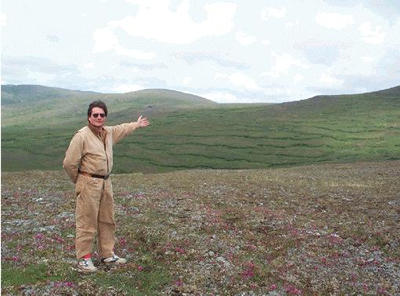Winter C-Flux In Arctic Ecosystems Under Changing Climate: Effects Of Soil Carbon And Active Layer Dynamics.
Project Personel
Main Contact: William Cable
Scientific Personel: Chien-Lu Ping, G. Michaelson, Xiao-Yan Dai (Palmer Research Station UAF), V. E. Romanovsky, D.O. Sergueev. (UAF)
Collaborators:
Partner Organizations:
Project Summary
 Under a continuous build-up of greenhouse gases in the atmosphere general circulation models predict climate warming. Climate warming at northern latitudes may be several times greater than the global average. The temperature increase in high latitudes might be more pronounced in the winter. A positive feedback of some arctic ecosystems to climate warming may contribute substantial amount of C to the atmosphere. Most trace-gas budgets assumed that trace-gas exchange stops when soil temperatures decrease to 0ºC and the contribution of CO2 from alpine and arctic regions in winter has not been considered to be important in calculations of global carbon balances. Hence, a possible increase in the winter decomposition of the organic matter in the surface active layer of the permafrost was ignored.
Under a continuous build-up of greenhouse gases in the atmosphere general circulation models predict climate warming. Climate warming at northern latitudes may be several times greater than the global average. The temperature increase in high latitudes might be more pronounced in the winter. A positive feedback of some arctic ecosystems to climate warming may contribute substantial amount of C to the atmosphere. Most trace-gas budgets assumed that trace-gas exchange stops when soil temperatures decrease to 0ºC and the contribution of CO2 from alpine and arctic regions in winter has not been considered to be important in calculations of global carbon balances. Hence, a possible increase in the winter decomposition of the organic matter in the surface active layer of the permafrost was ignored.
However, winter microbiological activity in soils was documented and a spatial heterogeneity in the decomposition of organic matter (OM) was observed. The causes of this spatial heterogeneity are poorly understood, though this understanding is very important for the scaling issue and for generalization of the results of flux studies obtained for the specific sites over vast areas. Microbial activity can exist only in the presence of sufficient amount of liquid phase of water in soils during the winter time. The variability in the decomposition of OM may have similar patterns with the spatial variability of the unfrozen water contents in the frozen active layer which, in turn depends upon physical/chemical properties of soils, the nature of available substrates, temperature regimes, etc. The interaction between microbial communities and these factors was never evaluated. A major gap remains in the understanding of the mechanisms that control ecosystem feedbacks to climatic change at high latitudes and, therefore, of the interaction between the Earth's land surface and the atmosphere. The evaluation of the rate of microbial decomposition under below-zero temperatures corresponding to the current and warming climates, and the mechanisms which control the rate of the low-temperature microbial decomposition is crucial to the assessments of ecosystems responses to global climate change. However, this problem was never addressed.
The scope of work in this research project includes measurements of the rate of OM decomposition in laboratory experiments under a range of below-zero temperatures which correspond to current and changing climatic conditions of the permafrost zone. The influence of the mineral composition of soils, properties of OM, and the amount of unfrozen water content on the microbial decomposition of OM under below-zero temperatures will be investigated. The results of the measurements will be extrapolated to the circumpolar permafrost region.


